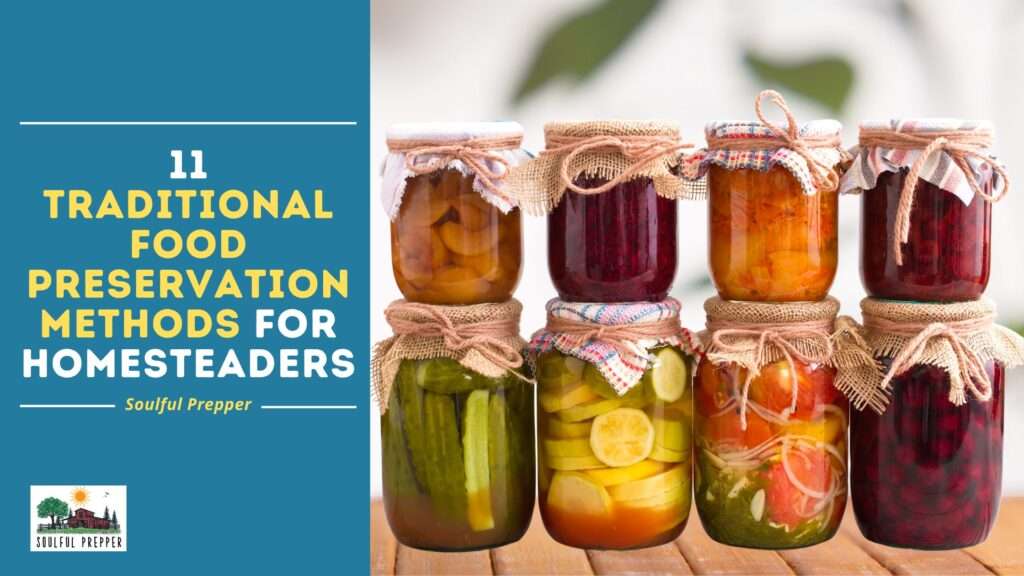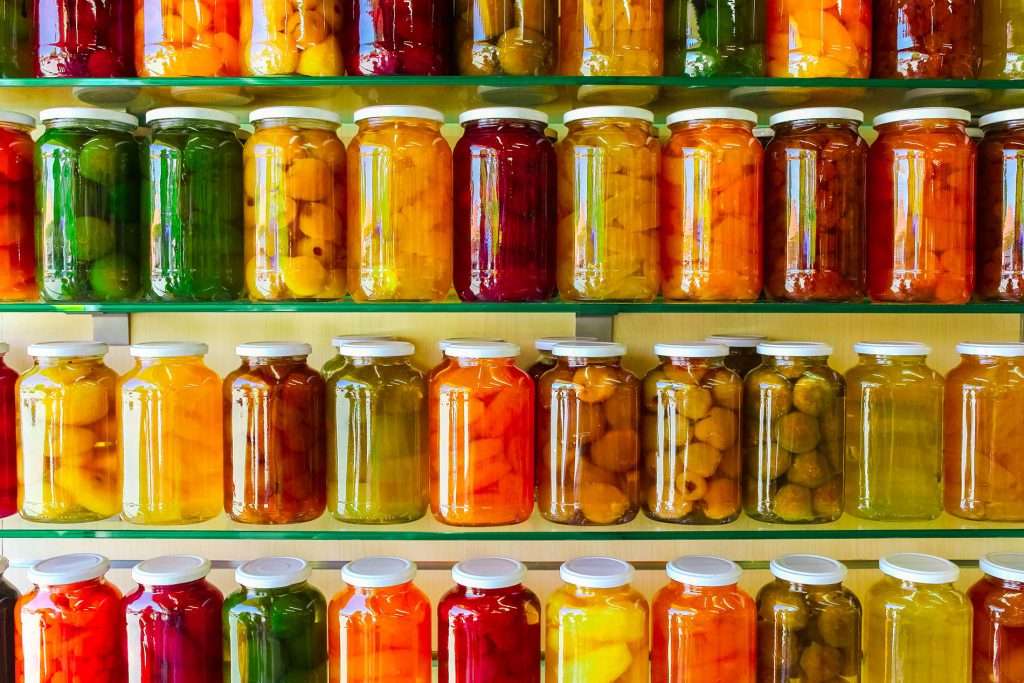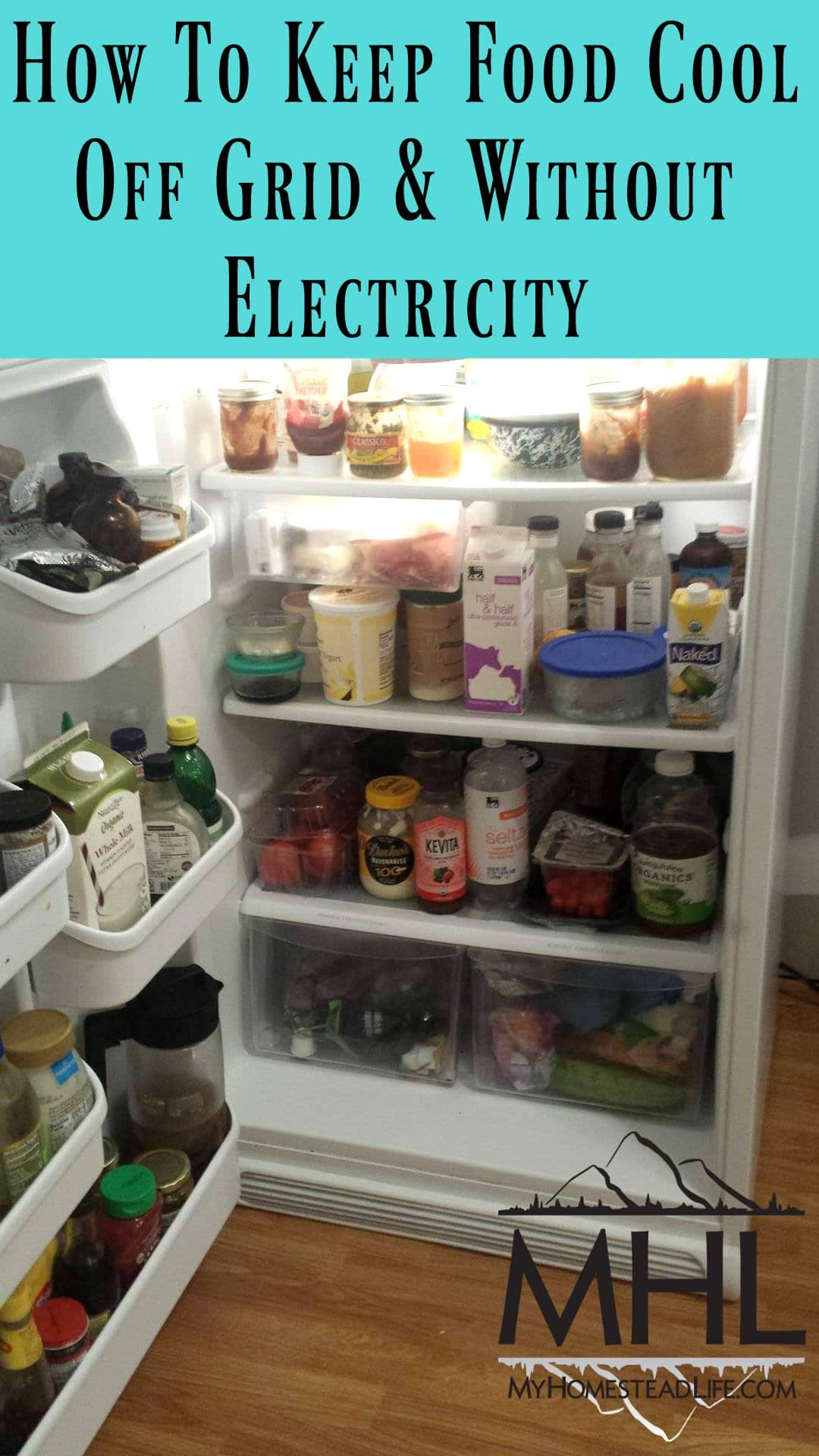In this article, we will be discussing food preservation methods specifically for off grid living. We understand that when you’re living off the grid, it may not always be easy to access fresh food, and that’s where these methods come in handy. Throughout the article, you will learn about four safe and effective methods for storing food that can help you maintain a steady food supply. So, if you’re interested in learning how to preserve your food for longer periods of time while living off the grid, keep reading!
A Guide to Food Preservation Methods for Off Grid Living

Introduction
Living off the grid can be a rewarding and sustainable way of life. However, one of the challenges faced by off grid dwellers is ensuring access to fresh and nutritious food. Without the convenience of a nearby grocery store, it becomes necessary to explore various food preservation methods. In this guide, we will discuss four effective methods for storing food safely: canning, drying, fermenting, and freezing. Each method has its unique benefits and considerations, and by understanding and implementing these techniques, you can ensure a steady supply of food in your off grid lifestyle.
Canning
Canning is a popular food preservation method that involves sealing foods in glass jars, preventing the growth of bacteria and other microorganisms. There are two primary canning methods: water bath canning and pressure canning.
Water Bath Canning
Water bath canning is suitable for high-acid foods such as fruits, pickles, and jams. It involves submerging jars of food in boiling water for a specific amount of time. The heat kills any microorganisms present in the food, ensuring its long-term storage.
Pressure Canning
Pressure canning, on the other hand, is necessary for low-acid foods such as vegetables, meats, and poultry. It involves using a specialized pressure canner to reach higher temperatures than water bath canning. The higher temperatures eliminate the risk of botulism and other harmful bacteria.
Equipment and Supplies Required
To engage in canning, you will need a few essential tools and supplies. These include glass jars with lids and screw bands, a water bath canner or pressure canner, a jar lifter, a canning funnel, and a recipe book with precise instructions.
Step-by-Step Guide to Water Bath Canning
- Prepare your jars and lids by washing them thoroughly in hot, soapy water.
- Fill the canner with enough water to cover the jars by at least one inch. Bring the water to a boil.
- Prepare your food by following a trusted canning recipe.
- Fill the hot jars with your prepared food, leaving the recommended headspace.
- Wipe the jar rims to ensure a clean seal, then place the lids on the jars.
- Using the jar lifter, carefully lower the filled jars into the boiling water bath canner.
- Process the jars for the specified amount of time, depending on the recipe.
- Remove the jars from the canner using the jar lifter and let them cool undisturbed for 12 to 24 hours.
- After cooling, check the seals by pressing the center of each lid. If it pops back, the jar did not seal properly and should be refrigerated or reprocessed.
- Store the properly sealed jars in a cool, dark place.
Step-by-Step Guide to Pressure Canning
- Prepare your jars and lids by washing them thoroughly in hot, soapy water.
- Fill the pressure canner with the required amount of water, following the manufacturer’s instructions.
- Prepare your food by following a trusted canning recipe.
- Fill the hot jars with your prepared food, leaving the recommended headspace.
- Wipe the jar rims to ensure a clean seal, then place the lids on the jars.
- Place the filled jars in the pressure canner, following the recommended arrangement.
- Fasten the lid securely and adjust the pressure to the specified level.
- Allow the canner to vent steam for the recommended duration, then close the vent and allow the pressure to build.
- Process the jars at the specified pressure for the recommended time.
- After the processing time is up, turn off the heat and let the canner depressurize naturally.
- Carefully remove the jars from the canner using the jar lifter and let them cool undisturbed for 12 to 24 hours.
- Check the seals as described in the water bath canning guide, and store the properly sealed jars in a cool, dark place.

Drying
Drying is a simple and effective method for preserving food. It involves removing moisture from the food, inhibiting the growth of bacteria and other spoilage organisms. There are different drying methods, including sun drying, air drying, and dehydrator drying.
Sun Drying
Sun drying is a traditional method that relies on the heat and airflow from the sun to dehydrate food. It is best suited for hot and arid climates. To sun dry food, slice it into thin, even pieces, and place them on a clean drying rack or tray. The food should be exposed to direct sunlight for several days until it reaches the desired dryness.
Air Drying
Air drying, also known as room drying, is suitable for foods that require moderate drying temperatures. It involves placing the food in a well-ventilated area with low humidity. Hang the foods or place them on drying racks, ensuring proper airflow around each piece. Air drying may take anywhere from a few days to a few weeks depending on the food and drying conditions.
Dehydrator Drying
Using a dehydrator is a convenient and efficient method for drying food. Dehydrators are designed to control temperature and airflow, ensuring consistent results. Simply slice the food into even pieces and place them on the dehydrator trays. Set the dehydrator to the recommended temperature and drying time specified in the user manual.
Choosing the Right Drying Method
When choosing a drying method, consider factors such as the climate, available space, and personal preference. Sun drying is suitable for hot and dry climates, while air drying and dehydrator drying can be done in any environment with proper airflow. Dehydrator drying offers more control and convenience but requires electricity.
Preparation and Process for Sun Drying
- Select ripe and fresh produce, free from any signs of spoilage.
- Wash and peel the fruits or vegetables, if necessary.
- Slice the food into thin, even pieces, ensuring uniform thickness for even drying.
- Lay the slices on a clean drying rack or tray, ensuring they do not touch.
- Place the drying rack or tray in a sunny location with good airflow.
- Cover the drying rack or tray with a fine mesh or cheesecloth to protect the food from insects and debris.
- Rotate the food periodically to ensure even drying.
- Depending on the food and drying conditions, sun drying may take several days to a few weeks.
- Once the food is completely dry, remove it from the drying rack or tray and store it in airtight containers in a cool, dark place.
Preparation and Process for Air Drying
- Select ripe and fresh produce, free from any signs of spoilage.
- Wash and peel the fruits or vegetables, if necessary.
- Slice the food into thin, even pieces, ensuring uniform thickness for even drying.
- Arrange the slices on clean drying racks or hang them individually.
- Place the drying racks or hang the food in a well-ventilated area with low humidity.
- Ensure there is adequate distance between the food pieces to allow proper airflow.
- Rotate the food periodically to ensure even drying.
- Air drying may take anywhere from a few days to a few weeks, depending on the food and drying conditions.
- Once the food is completely dry, remove it from the drying racks or hanging positions and store it in airtight containers in a cool, dark place.
Preparation and Process for Dehydrator Drying
- Select ripe and fresh produce, free from any signs of spoilage.
- Wash and peel the fruits or vegetables, if necessary.
- Slice the food into even pieces, following the dehydrator’s guidelines for thickness.
- Arrange the slices on the dehydrator trays, ensuring they do not overlap.
- Place the trays in the dehydrator, following the manufacturer’s instructions.
- Set the dehydrator to the recommended temperature and drying time.
- Regularly check the food for dryness and rotate the trays for even drying.
- Remove the food from the dehydrator when it is completely dry and store it in airtight containers in a cool, dark place.
Fermenting
Fermentation is a preservation method that involves the transformation of carbohydrates in food into organic compounds such as alcohol, lactic acid, or acetic acid by microorganisms. This process not only extends the shelf life of food but also enhances its flavor and promotes beneficial bacteria for gut health.
Understanding the Fermentation Process
Fermentation is a natural process that occurs when microorganisms, mainly bacteria and yeast, break down carbohydrates in the absence of oxygen. These microorganisms convert sugars into various compounds, such as alcohol or acids, which act as preservatives.
Fermentation Equipment and Supplies
To begin fermenting food, you will need a few essential tools and supplies. These include fermentation vessels such as glass jars or crocks, fermentation weights to keep the food submerged, non-iodized sea salt or pickling salt, and a fermentation airlock system.
Fermenting Vegetables
Vegetables are excellent candidates for fermentation due to their high water content and nutrient-rich composition. To ferment vegetables, start by washing and cutting the vegetables into desired shapes. Then, prepare a brine solution using non-iodized sea salt and water. Submerge the vegetables in the brine, ensuring they are fully covered, and use a fermentation weight to keep them submerged. Finally, place an airlock system on the fermentation vessel, allowing the gases produced during fermentation to escape while preventing oxygen from entering.
Fermenting Fruits
Fermenting fruits can result in unique flavors and aromas. To ferment fruits, select ripe and fresh produce without any signs of spoilage. Wash and cut the fruits into smaller pieces. Combine the fruits with a sugar solution or natural fruit juice, ensuring the fruits are fully immersed. Place an airlock system on the fermentation vessel to maintain an anaerobic environment.
Fermenting Dairy Products
Fermenting dairy products such as yogurt and kefir is a popular practice. To make yogurt, heat milk to a specific temperature, then add a starter culture containing live bacteria that will ferment the milk. Allow the mixture to ferment at a specific temperature for a certain duration, depending on the desired consistency and tanginess. Kefir, on the other hand, involves fermenting milk with kefir grains, resulting in a tangy and slightly effervescent beverage.
Step-by-Step Guide to Fermenting Vegetables
- Select fresh vegetables and wash them thoroughly.
- Cut the vegetables into desired shapes, such as slices or shreds.
- Prepare a brine solution using non-iodized sea salt and water. The ratio of salt to water varies depending on the desired flavor and texture.
- Submerge the vegetables in the brine solution, ensuring they are fully covered.
- Place a fermentation weight on top of the vegetables to keep them submerged in the brine.
- Place an airlock system on the fermentation vessel to create an anaerobic environment.
- Ferment the vegetables at a specific temperature for the recommended duration, usually ranging from a few days to several weeks.
- Taste the vegetables periodically to monitor their flavor and texture.
- Once the vegetables reach the desired taste, remove the airlock system and store the fermented vegetables in the refrigerator or a cool, dark place.
Step-by-Step Guide to Fermenting Fruits
- Select ripe and fresh fruits, free from any signs of spoilage.
- Wash the fruits thoroughly and cut them into smaller pieces.
- Prepare a sugar solution by dissolving sugar in water. The ratio of sugar to water varies depending on the desired level of sweetness.
- Place the fruit pieces in a fermentation vessel, ensuring they are fully immersed in the sugar solution.
- Place an airlock system on the fermentation vessel to maintain an anaerobic environment.
- Ferment the fruits at a specific temperature for the recommended duration, typically ranging from a few days to several weeks.
- Taste the fruits periodically to monitor their flavor and aroma.
- Once the fruits reach the desired taste, remove the airlock system and store the fermented fruits in the refrigerator or a cool, dark place.
Step-by-Step Guide to Fermenting Dairy Products
- Heat milk to a specific temperature, following a trusted recipe or manufacturer’s instructions.
- Allow the milk to cool to a specific temperature range.
- Add a starter culture containing live bacteria to the milk. The bacteria will ferment the milk, transforming it into yogurt.
- Stir the milk and starter culture gently to ensure even distribution.
- Place the milk mixture in a fermentation vessel or individual containers, depending on the desired yield.
- Place the fermentation vessel or containers in a warm location, such as an oven with the pilot light on or a yogurt maker.
- Let the milk ferment for the recommended duration, typically ranging from a few hours to overnight, depending on the desired consistency and tanginess.
- Once the yogurt has reached the desired taste, transfer it to the refrigerator to cool and set completely.
- For kefir, add kefir grains to milk and allow the mixture to ferment at room temperature for the recommended duration, periodically giving it a gentle stir.
- After fermentation, strain the kefir grains from the milk and transfer the kefir to the refrigerator to chill before consuming.

Freezing
Freezing is a popular food preservation method that involves lowering the temperature of food to inhibit the growth of microorganisms and enzymes that cause spoilage. Freezing can be done using various containers and packaging, and it is suitable for a wide range of foods.
Choosing the Right Containers and Packaging
When freezing food, it is important to choose containers and packaging that are durable and airtight. Freezer-safe plastic containers, glass jars, and heavy-duty freezer bags are commonly used. Make sure the containers or bags have airtight lids or seals to prevent freezer burn and maintain the quality of the food.
Preparing the Food for Freezing
Before freezing, it is essential to prepare the food properly to maintain its quality. Blanching is a common technique used to prepare vegetables for freezing. Blanching involves briefly boiling the vegetables, then immediately placing them in ice water to stop the cooking process. This pre-treatment helps retain the color, texture, and nutritional value of the vegetables.
Packaging and Labeling
When packaging food for freezing, ensure it is completely cooled before sealing the containers or bags. Remove any excess air from the containers or bags to prevent freezer burn. Label each package with the contents and the date of freezing. This will help you keep track of the foods and their storage duration, allowing you to prioritize their use.
Freezing Fruits and Vegetables
Freezing fruits and vegetables is a convenient way to preserve their nutritional value and flavor. Start by washing and peeling the fruits or vegetables, if necessary. Cut them into desired sizes or leave them whole, depending on your preference. Pack the fruits or vegetables into freezer-safe containers or bags, leaving some headspace for expansion. Seal the containers or bags tightly and place them in the freezer.
Freezing Meat and Fish
To freeze meat and fish, ensure they are fresh and free from any signs of spoilage. Trim off any excess fat or connective tissue. Wrap the meat or fish tightly in plastic wrap or aluminum foil to prevent freezer burn. Place the wrapped meat or fish in freezer-safe containers or bags, removing any excess air. Seal the containers or bags tightly and place them in the freezer.
Freezing Dairy Products
Dairy products such as milk, cheese, and butter can also be easily frozen. For milk, ensure it is stored in a freezer-safe container, leaving some headspace for expansion. Cheese can be grated or sliced, then packed into freezer-safe bags or containers. Butter can be frozen as is or divided into smaller portions before freezing.
Thawing and Using Frozen Food
When thawing frozen food, it is important to follow safe thawing practices to prevent bacterial growth. The recommended methods for thawing are in the refrigerator, submerged in cold water, or using the defrost function on a microwave. Do not thaw frozen food at room temperature, as this can promote bacterial growth. Once thawed, use the food promptly and do not refreeze unless it has been cooked.
Benefits and Considerations of Each Method
Each food preservation method has its unique benefits and considerations. Understanding these factors will help you choose the most suitable method for your off grid living.
Long-Term Storage
Canning, drying, fermenting, and freezing are all excellent methods for long-term food storage. Canned foods can last for up to a year or more, while properly dried foods can remain edible for several months. Fermented foods can be stored for months or even years, depending on the specific food and fermentation process. Frozen foods, when stored at or below 0°F (-18°C), can last indefinitely, although the quality may deteriorate over time.
Preservation of Nutritional Value
All four preservation methods can help retain the nutritional value of food to some extent. Canning and freezing may result in slight nutrient losses due to the heat exposure during processing. Drying can cause more significant nutrient losses, particularly for heat-sensitive vitamins. Fermentation, on the other hand, can enhance the bioavailability of certain nutrients and increase the production of beneficial compounds.
Flavor and Texture Retention
Canning, drying, fermenting, and freezing can all help preserve the flavor and texture of food. Canned foods generally maintain their flavor and texture well, although some slight changes in texture may occur over time. Dried foods may have a more concentrated flavor and a different texture, depending on the food being dried. Fermented foods often have unique and complex flavors, while frozen foods can retain the original flavor and texture when properly thawed.
Cost and Time Considerations
The cost and time required for each preservation method can vary. Canning may require an initial investment in equipment and supplies, but the cost per jar is relatively low. Drying and fermenting generally require minimal equipment and supplies, but they can be time-consuming depending on the specific food and process. Freezing requires a freezer and associated energy costs, and the packaging materials may also add to the overall expense.

Factors to Consider for Off Grid Living
Living off the grid brings additional considerations when choosing a food preservation method.
Energy Requirements
Canning, drying, and fermenting do not require electricity, making them suitable for off grid living. These methods rely on natural processes and can be done using basic tools and equipment. Freezing, on the other hand, requires electricity to power the freezer, making it more energy-intensive.
Availability of Ingredients
The availability of ingredients may influence your choice of preservation method. Canning, drying, and fermenting can be done with a wide range of fruits, vegetables, and other ingredients. Consider the local climate and what produce is readily available in your area. Freezing allows for more flexibility in terms of ingredient availability, as you can freeze a variety of foods regardless of seasonal availability.
Temperature and Climate
The temperature and climate in your off grid location may also impact your choice of preservation method. Canning, drying, and fermenting can be done in any climate, as they do not rely on specific temperature conditions. However, extreme temperatures can affect the quality and shelf life of canned and fermented foods. Freezing, on the other hand, requires a consistently low temperature to maintain the quality of frozen foods.
Storage Space
Consider the available storage space in your off grid dwelling when choosing a preservation method. Canning requires adequate shelf or storage space for jars, while drying and fermenting may require designated areas for hanging or storing food. Freezing requires enough freezer space to accommodate the amount of food you wish to freeze.
Choosing the Right Food Preservation Method for Your Needs
When choosing a food preservation method for off grid living, it is essential to assess your specific situation and consider personal preferences.
Assessing Your Off Grid Living Situation
Consider your energy source, available storage space, and access to ingredients. Assess your living conditions and determine which preservation methods are most practical and feasible for your off grid lifestyle.
Considering Personal Preferences
Take into account your personal preferences for taste, texture, and convenience. Some people may prefer the taste and texture of canned foods, while others may enjoy the unique flavors of fermented or dried foods. Consider the level of effort and time required for each method and choose the one that aligns with your preferences and priorities.
Planning for Variety and Versatility
It is beneficial to incorporate a variety of preservation methods into your off grid food storage plan. Different methods have different advantages and limitations, and by diversifying your food preservation techniques, you can enjoy a wider range of preserved foods. Plan for versatility in your meals by preserving a mix of fruits, vegetables, meats, and dairy products using various methods.

Tips and Tricks for Successful Food Preservation
Implementing the following tips and tricks will help you achieve successful food preservation and maintain food safety.
Proper Cleaning and Sterilization
Ensure all equipment, utensils, and surfaces are clean and sterilized before starting the preservation process. This prevents contamination and extends the shelf life of preserved foods. Follow proper cleaning and sterilization procedures for canning jars, drying racks, fermentation vessels, and any other equipment used in the preservation process.
Using Quality Ingredients
Use fresh, high-quality ingredients for optimal results. Choose fruits and vegetables that are at their peak ripeness, as this will enhance the flavor and nutritional value of the preserved food. Avoid using overripe or spoiled produce, as this can affect the quality and safety of the preserved food.
Safe Handling and Storage
Practice safe handling and storage practices to prevent foodborne illnesses. Wash your hands thoroughly before handling any food, and avoid cross-contamination by using separate cutting boards and utensils for different types of foods. Store preserved foods in clean, airtight containers in cool, dark places to maintain their quality and keep them safe for consumption.
Monitoring and Rotation
Regularly monitor your stored food for any signs of spoilage or deterioration. Check for mold, off odors, or changes in texture or color. Implement a rotation system to ensure that older preserved foods are used first, reducing the risk of food waste.
Adapting Recipes for Preservation
When using recipes for preserved foods, always follow trusted sources and guidelines. Some recipes may need to be adapted for preservation purposes, such as adjusting the acidity level for canning or modifying the sugar content for fermentation. Follow reliable recipes and consult reputable sources to ensure successful preservation.
Common Mistakes to Avoid
Avoid these common mistakes to ensure successful food preservation and maintain food safety.
Ignoring Safety Guidelines
Ignoring safety guidelines can result in foodborne illnesses or spoilage. Always follow proper canning procedures, including recommended processing times, processing pressures, and jar sterilization. When fermenting, ensure proper salt concentrations and monitor the fermentation process to prevent the growth of harmful bacteria. Practice safe thawing methods for frozen foods to avoid bacterial growth.
Inconsistent Processing Times
Inconsistent processing times can compromise the safety and quality of preserved foods. When canning, follow the recommended processing times for your specific recipe and altitude. Incorrect pressure levels and processing times for pressure canning can result in underprocessing, leading to spoiled or unsafe food.
Overpacking Containers
Overpacking containers can lead to inadequate heat penetration during canning or improper freezing. Leave the recommended headspace in canning jars to allow for expansion and create a proper vacuum seal. When freezing, ensure there is enough space for the food to freeze evenly and prevent the containers from bursting.
Mislabeling Packages
Mislabeling packages can lead to confusion and incorrect storage practices. Always label the preserved food packages with the contents and the date of preservation. Properly labeling packages allows you to track the age of the preserved food and prioritize its use, reducing the risk of consuming spoiled or expired food.
Conclusion
Preserving food for off grid living is essential for ensuring access to fresh and nutritious meals. By understanding and implementing various food preservation methods, such as canning, drying, fermenting, and freezing, you can enhance the shelf life of food while maintaining its nutritional value and flavor. Consider the benefits and considerations of each method, and assess your specific off grid living situation to choose the most suitable preservation techniques. With proper planning, safe handling, and adherence to guidelines, you can enjoy a diverse and sustainable food supply in your off grid lifestyle.




